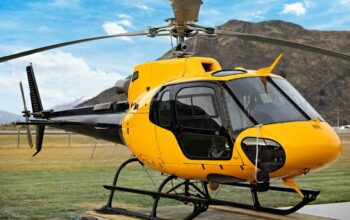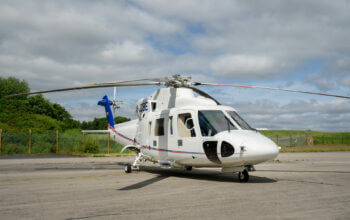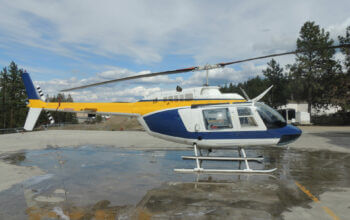The Helicopter Company (THC) has provided more details on the framework agreements it signed at Heli-Expo for up to 250 helicopters, as the Saudi Arabian company continues its historic ramp up on its journey to becoming one of the largest civil helicopter operators in the world.
“[Heli-Expo] was fantastic for us,” A.J. Baker, THC’s chief commercial officer, told Vertical. “The show for us wasn’t just about the big bang with what we announced, it was about a credibility check and an opportunity for some of our key stakeholders to see where we sit with the rest of the industry.”
THC, backed by Saudi Arabia’s Public Investment Fund, was established just five years ago as the country’s first national commercial helicopter operator.
The operator received its first aircraft at the end of 2019, but now has a fleet of 48 working from 15 bases. They work in a variety of sectors, including emergency medical services (EMS), tourism, VVIP transportation and utility work.
Today, the company has close to 900 staff — and between 200 and 300 of those are pilots.
The pace of THC’s operational ramp-up is unrelenting: it will receive 18 helicopters this year, more than 20 in 2025, and the same in 2026. “The way we look at it, it’s around one aircraft every three weeks for the next three years,” said Baker.
The framework agreements announced at Heli-Expo include firm orders that form part of this near-term ramp-up, but the majority of the aircraft are options for the latter half of the decade.
The agreement with Airbus was for up to 120 aircraft, including firm orders for eight H125s. Separately, there were 10 H145s that were options from an earlier agreement that were converted to firm orders. The H125s will be used for aerial work and tourism, while the H145s will perform various roles, including corporate and air medical transport.
THC now has a firm orderbook of 60 Airbus aircraft (10 H160s, 20 H125s and 30 H145s), with 25 of those already in service.

Baker said the framework with Airbus is “slanted more towards the singles.” THC is planning to use these to support the future developments across the Kingdom’s “Giga projects.”
“As these new developments start to open resorts and people start to come, we see the need for vertical lift in both movement to and from places and for a growing tourism demand,” he said.
The framework with Leonardo is for up to 130 aircraft, including AW109s, AW169s, AW139s, and AW189Ks (the version of the AW189 powered by the Safran Aneto-1K, providing 28 percent more power at takeoff).
THC also announced firm orders for 20 AW139s, converted from options from an earlier agreement. These will be used for corporate, EMS and other emerging operations. Baker described the type as THC’s “workhorse,” and when the new aircraft are delivered, the operator will have a fleet of close to 50 AW139s, making it the owner of one of the largest AW139 fleets in the world.
THC will likely use the AW109s and AW169s for VIP transportation, he added.
Baker said the operator likely won’t take delivery of all 250 aircraft covered by the frameworks, as some duplication of its requirements has been built in across the two. For example, the company may only choose to operate one type of super medium aircraft, but both the AW189 and H175 are in the frameworks with Leonardo and Airbus, respectively
“They’re both in the mix — we’re just not quite sure which way we’re going to go yet,” he said.
The total of super mediums THC will ultimately require will be “greater than 10 and less than 25,” said Baker. The aircraft will be used in “very demanding areas,” he said.
“We have some areas that are very high, but still very hot,” he explained. “So we need to be able to operate at 8,000 feet [2,440 meters] at 25 C [77 F] in the middle of summer…. There’s not too many aircraft on the planet that can do that, and still be at a high [enough] performance level to do winching operations or landings and set downs.”
A secure pipeline of aircraft
One of the benefits of signing these large-scale agreements with the OEMs is the guarantee of delivery slots in a competitive market, said Baker.
“We all can see what’s happening in the industry: You order an aircraft today, and you can have it in 2027,” he said. “We wanted to avoid that, which is why we’ve locked slots in every year.”
The frameworks are weighted with more aircraft towards the back end of the timeline on the basis that THC will be beginning its fleet renewal by the end of the decade.
“Eight to 10 years [with each aircraft] is probably about the sweet spot for our plan,” said Baker. “The older aircraft go straight across to [THC-owned reseller] Rotortrade into the aftermarket world. We continue with aircraft that are on full PBH [power by hour] programs and under warranty. It’s a model that works for us.”
The operator’s focus on aircraft from just two OEMs is a result of Airbus and Leonardo topping the responses from a major request for proposals THC issued in 2021.
“It really has been a case of once the foot was in the door, it was going to take some effort for somebody else to join that,” said Baker. “We’ve looked at that a couple of times with other OEMs, but so far there hasn’t been a product that would work better and/or at a better price point to deliver on our requirements.”
He said in-country investment and support from OEMs was also a major consideration. Airbus, he said, has over 80 people in the Kingdom (not all are devoted to supporting THC), good in-country logistics and spares, and numerous technicians embedded with the operator. Leonardo has personnel embedded with THC’s MRO facility in Jeddah, who are currently helping the operator complete its first four-year inspection.
Looking ahead to the rest of 2024, Baker said the company’s focus is on building up the infrastructure it requires.
“We’re building hangars in all of our locations this year,” he said. “That’s been a little bit of catch-up — because we just had to get the aircraft operating. But we don’t want to go through a second summer with aircraft that aren’t undercover and without really decent facilities for our people to be in.”









